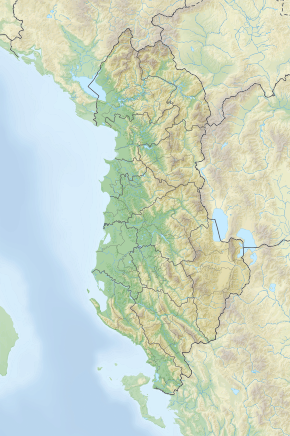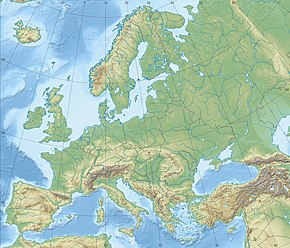Tirana
Tirona | |
|---|---|
Toptani Centre Clock Tower Pyramid of Tirana Dajti Cable Car University of Tirana | |
| Coordinates: 41°19′38″N 19°49′07″E / 41.32722°N 19.81861°E | |
| Country | Albania |
| Region | Central Albania |
| County | Tirana |
| Municipality | Tirana |
| Settled | 1614 |
| Government | |
| • Type | Mayor–council |
| • Mayor | Erion Veliaj[1] (PS) |
| • Council | Tirana Municipal Council |
| • Chairman | Toni Gogu[2] |
| Area | |
| • Total | 1,110 km2 (430 sq mi) |
| • Unit | 41.8 km2 (16.1 sq mi) |
| Elevation | 110 m (360 ft) |
| Population | |
| • Municipality | 598,176[a] |
| • Municipality density | 538/km2 (1,390/sq mi) |
| • Unit | 389,323[8] |
| • Unit density | 9,313/km2 (24,120/sq mi) |
| Demonym(s) | Albanian: Tiranas (m), Tiranase (f) Tirana dialect: Tirons (m), Tironse (f) |
| GDP | |
| • Municipality | €6.6 billion (2021)[9] |
| • Per capita | €7,235 (2021)[10] |
| Time zone | UTC+1 (CET) |
| • Summer (DST) | UTC+2 (CEST) |
| Postal code(s) | 1000-1054 |
| Area code(s) | +355 (0) 4 |
| Airport | Nënë Tereza Airport |
| Motorways | |
| Highways | |
| Vehicle registration | TR |
| Website | tirana |
Tirana[b] (/tɪˈrɑːnə/ tih-RAH-nə,[11][12] Albanian pronunciation: [tiˈɾana]; Gheg Albanian: Tirona) is the capital and largest city of Albania. It is located in the centre of the country, enclosed by mountains and hills, with Dajti rising to the east and a slight valley to the northwest overlooking the Adriatic Sea in the distance. It is among the wettest and sunniest cities in Europe, with 2,544 hours of sun per year.[13][14]
Tirana was founded in 1614 by Ottoman Albanian general Sylejman Pasha Bargjini, centered on the Old Mosque and türbe. The site of present-day Tirana has been continuously inhabited since the Iron Age and was likely the core of the Illyrian Kingdom of the Taulantii, which in Classical Antiquity was centred in the hinterland of Epidamnus. Following the Illyrian Wars, it was annexed by Rome and became an integral part of the Roman Empire; the heritage of that period is reflected by the Mosaics of Tirana. With the collapse of the Western Roman Empire in the fourth century, most of Albania came under the control of the eastern Byzantine Empire, as evident by the Petrelë Castle built during the reign of Justinian I. The city was fairly unimportant until the 20th century, when the Congress of Lushnjë proclaimed it as Albania's capital after the Albanian Declaration of Independence in 1912.
Classified as a gamma-world-city,[15] Tirana is the most important economic, financial, political, and trade centre in Albania due to its significant location in the centre of the country and its modern air, maritime, rail and road transportation.[16] As the seat of power of the Government of Albania, it hosts the official residences of the President and Prime Minister of Albania and the Parliament of Albania. The city was announced as the European Youth Capital for 2022.
- ^ "Mayor of Tirana". Bashkia Tiranë. Archived from the original on 23 September 2020. Retrieved 23 September 2020.
- ^ "Municipal chairman of Tirana". Bashkia Tiranë. Archived from the original on 23 September 2020. Retrieved 23 September 2020.
- ^ a b c "Pasaporta e Bashkisë Tirana" (in Albanian). Porta Vendore. Archived from the original on 6 October 2021. Retrieved 6 October 2021.
- ^ "Bashkia Tirana". Albanian Association of Municipalities (AAM). Archived from the original on 12 October 2020. Retrieved 12 October 2020.
- ^ "A new Urban–Rural Classification of Albanian Population" (PDF). Instituti i Statistikës (INSTAT). May 2014. p. 15. Archived from the original (PDF) on 14 November 2019. Retrieved 6 October 2021.
- ^ Cite error: The named reference
Law 2014was invoked but never defined (see the help page). - ^ 2023 Albanian census 2024, p. 67.
- ^ "Census of Population and Housing". Institute of Statistics Albania.
- ^ "44% of the economy in 2021 concentrated in Tirana, other districts fading". euronews.al. 22 May 2023. Retrieved 5 April 2024.
- ^ "Economic inequality deepens year after year/ Tirana has the highest per capita income of 134% of the average". politiko.al. Retrieved 5 April 2024.
- ^ "Tirana". Lexico UK English Dictionary. Oxford University Press. Archived from the original on 26 February 2021.
- ^ "Tirana". The American Heritage Dictionary of the English Language (5th ed.). HarperCollins. Retrieved 21 September 2020.
- ^ "Sunniest Cities in Europe". currentresults.com. p. 1. Archived from the original on 19 January 2024. Retrieved 21 January 2024.
- ^ "European Cities With the Wettest, Rainiest Weather". currentresults.com. p. 1. Archived from the original on 8 December 2017. Retrieved 7 December 2017.
- ^ "GaWC - The World According to GaWC 2020". www.lboro.ac.uk. Retrieved 3 August 2024.
- ^ "The World According to GaWC 2020". Globalization and World Cities Research Network (GaWC). Archived from the original on 6 October 2020. Retrieved 6 October 2020.
Cite error: There are <ref group=lower-alpha> tags or {{efn}} templates on this page, but the references will not show without a {{reflist|group=lower-alpha}} template or {{notelist}} template (see the help page).













